Did you know that there are a variety of different types of turtles currently residing in Georgia? Unlike other states, Georgia is an ideal region to live in for both land and sea turtles.

Besides being located in North America, the state has many beaches, rivers, lakes, ponds, and even swamps, all ideal living environments for turtles of all shapes and sizes.
So, it should come as no surprise to hear that Georgia is home to around 40 species of turtles! In this article, we are going to be providing you with a helpful list that contains all the most noteworthy species of turtle that currently call Georgia home.
Under each turtle heading, you will find plenty of helpful information and insights into their characteristics, history, eating habits, and more – as well as some interesting and fun facts that will help you to understand each turtle type a little better.
In addition to helping you understand what types of turtles are located within the borders of Georgia, how they differ from one another, and why it’s important to protect them, you will even find a helpful F.A.Q section!
There, we will answer any more questions you might have regarding these turtles – especially if you’re thinking about owning one.
So, without further ado, whenever you’re ready, just read on to learn all about the different types of turtles in Georgia!
The Different Types Of Turtles In Georgia
The Bog Turtle
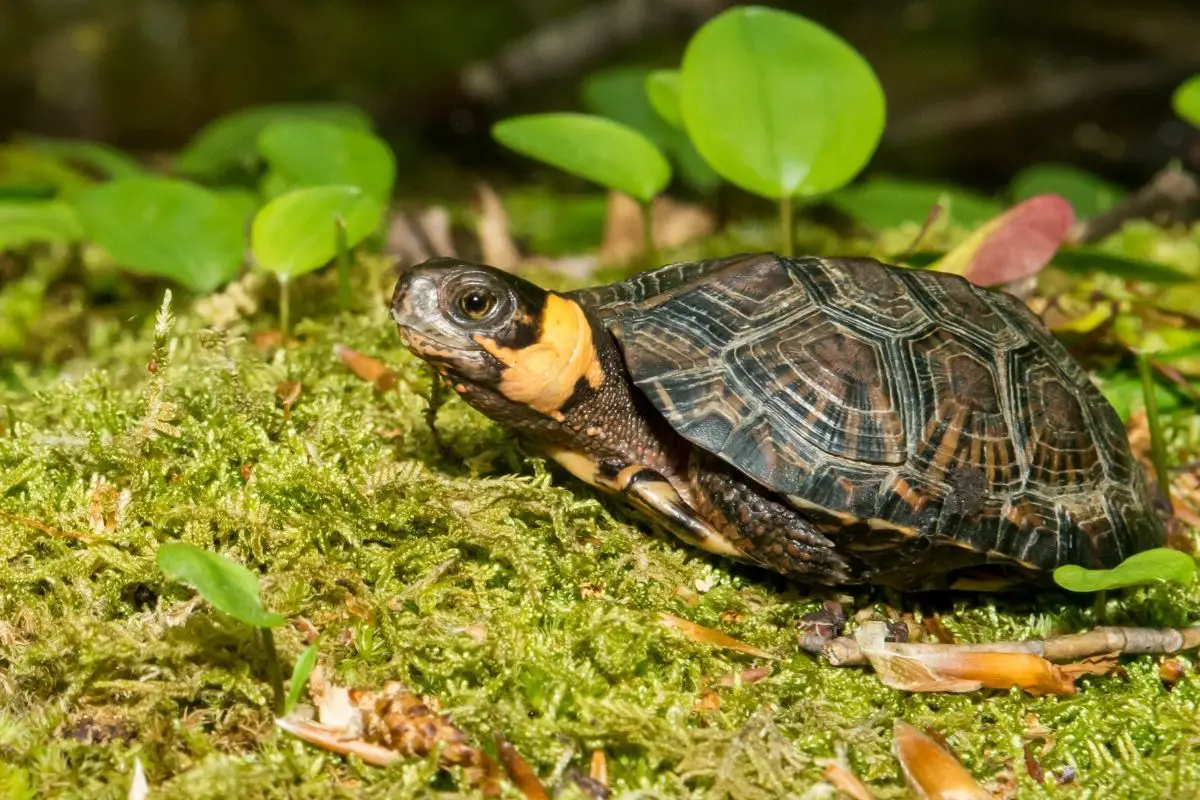
Kicking this ultimate guide off, we will start with the Bog turtle! The Bog Turtle is the first type of Turtle that can be found in Georgia.
These turtles live in swamps and bogs throughout the state – hence the name! These turtles are pretty easy to spot and have a dark green coloring with yellow, red, and even orange patches.
In order to ensure their survival, Bog turtles have a very thick shell that protects them from predators. If they are disturbed, they will quickly retreat into their shells.
Because of this, it’s important to keep your distance when you encounter one or approach them very slowly, so you do not accidentally scare them.
Interestingly enough, Bog Turtles are one of the smallest turtles found in North America.
As semi-aquatic turtles, they spend most of their time in the water or around swampy, muddy areas – and it should also come as no surprise to learn that their diet consists mainly of aquatic plants and insects.
At the time of writing, the Bog Turtle is considered an endangered turtle species that is unfortunately on the brink of extinction.
It’s estimated that there are only around 5,000 bog turtles left in the world today, and many steps are being taken to try to preserve them.
As an example, there are a variety of conservation charities located throughout the Georgia area that actively work to help prevent this species of turtle from going extinct, including preservation of its natural habitat, as well as ethical, captive breeding.
This is currently being undertaken via Georgia’s “Bog Turtle Head Start” incentive program, which consists of safely collecting female bog turtles and placing them in captivity while their eggs hatch.
Once the baby turtles have been born, they are held in captivity for a period of around 2 years.
After this, they are released into the wild, where they will typically choose to settle in grasslands near open bodies of water with plenty of yummy vegetation and aquatic plants to enjoy!
They can also quite often be found basking on top of clumps of vegetation soaking in the sunlight during the warmer months.
Here Are Some Fun Facts About The Bog Turtle
- Bog turtles are one of the smallest species of turtle in the world. In fact, they sally only grow to about 3-4 inches.
- They usually weigh between two and four pounds. So, they’re pretty light for a turtle.
- Their average lifespan is usually up to 100 years or even longer!
The Eastern Box Turtle
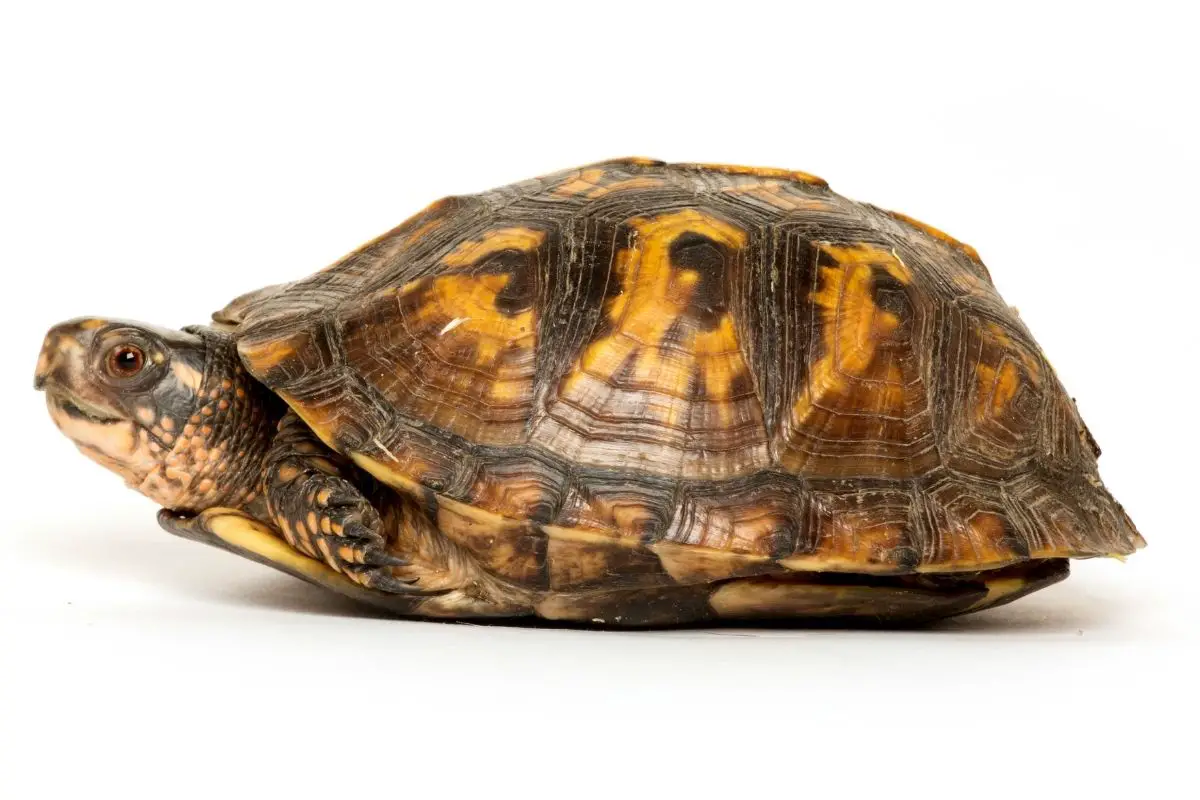
The next type of turtle that we are going to be talking you through is the Eastern Box Turtle! The Eastern box turtle is another common species of turtle that can be found in many areas of Georgia.
This particular species has a brownish-gray color with yellow stripes running down its back, while its head is typically covered in dark spots.
Just like other types of box turtles, these animals are omnivores and eat a wide variety of foods. Some of their favorite items include fruit, nuts, vegetables, eggs, meat, and even small fish!
It’s worth noting that the Eastern Box Turtle is an opportunistic hunter and is very good at adapting to a variety of different environments – which explains why they’re a prevalent figure in various parts of America.
Interestingly, Eastern Box turtles are often found residing in North America. However, they were once widely distributed across Europe, Asia, and Africa.
Unfortunately, due to habitat loss and hunting, many populations of eastern box turtles are now endangered.
Today, there are only around 100,000 remaining individuals living in the wild, so steps are also being taken in Georgia to help preserve this species of turtle, too.
Sometimes referred to as the “three-toed” turtle, the Eastern Box turtle is considered to be diurnal, which means that they are most active during the late spring and early fall.
Female turtles can also produce anywhere from 1 through to 6 clutches over a period of a few years after only mating just once.
This means that mating is not as frequent in this species of turtle as it might be in others, which many feels might also be contributing to the species’ conservation status.
Here Are Some Fun Facts About The Eastern Box Turtle
- They can reach lengths of up to five feet.
- They typically weigh between 25 and 50 lbs. So, some can be pretty heavy!
- They reside in North America, including Georgia. However, they are native to Europe, Asia, and Africa.
- They like to walk on wet highways after it has rained!
Are you interested in learning more about the Eastern Box Turtle? Check out this book.
The Common Snapping Turtle
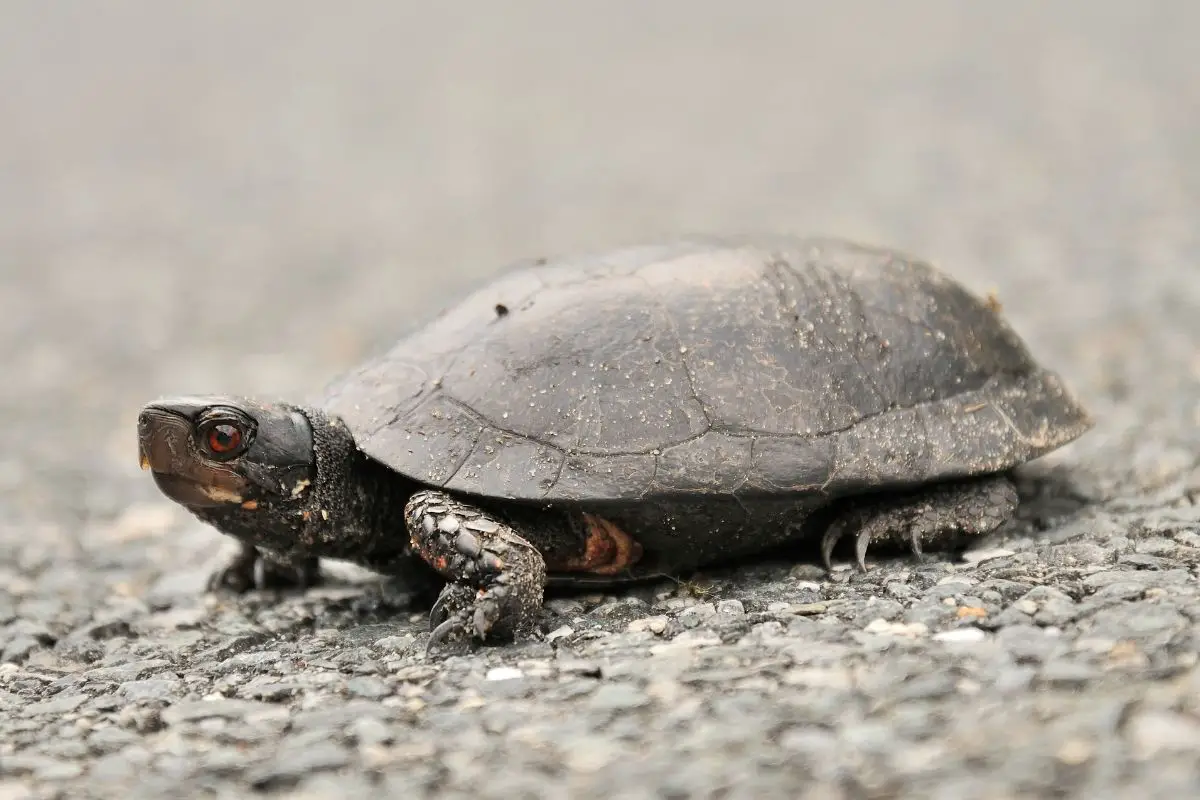
The Common snapping turtle is an extremely popular species of turtle that can often be seen at local zoos and parks. These turtles are native to the southeastern United States.
However, because of habitat loss, they’re now considered endangered. They also have a lifespan of around 30 years – although this can sometimes reach upwards of 40 years.
When they were first discovered, these turtles had a distinctive snout that could snap up prey like frogs and fish. Today, however, this feature has been lost. Instead, they use their strong jaws to crush their food!
If you’re interested in viewing some of these Snapping turtles for yourself, you might want to take a visit to a river, creek, or reservoir in your area – the Common Snapping turtle is often seen living in these areas of Georgia!
Common snapping turtles are omnivorous and feed primarily on crustaceans, reptiles, amphibians, and fish.
They may also consume insects, seeds, berries, and fruits. They are also known for being extremely territorial and aggressive towards other turtles.
To give you an idea of what we mean by this, if you happened to disturb a female while she’s nesting, she would more than likely attack you and do her best to protect her nest and hatchlings.
So, if you do plan on checking some out for yourself, don’t forget that the Snapping turtle can be a little territorial.
You should have no trouble spotting them among other types of turtles, as the Common Snapping Turtle often has a tail that extends as long as its body!
If you’re familiar with turtles, then you should also look out for tubercles that will be located on both the neck and legs of the Common Snapping turtle, as it helps them to sense changes in water and their other surroundings.
Here Are Some Fun Facts About The Common Snapping Turtle
- The Common Snapping turtle is one of the most fierce and territorial of all the species of turtles covered in this list.
- They have a natural lifespan of about 30 years in the wild, although in some instances, a Common Snapping turtle might live for longer than this. The longest recording of a Common Snapping turtle’s lifespan was 40 years.
- They can grow to be pretty large and can sometimes weigh upwards of 35-45 pounds!
- The Common Snapping turtle isn’t named that for just no reason. These turtles will often “snap” at threats or anything else deemed a potential predator with their strong, powerful jaws.
If you would like to learn a little more about the Common Snapping Turtle, then why don’t you consider checking out the following book?
The Alligator Snapping Turtle

Alligator snapping turtles are similar to the common snapping turtle, but they are much larger. They can grow as large as six feet in length and weigh anywhere from 200 to 300 lbs.
These turtles are native all to Georgia and have a distinctive alligator appearance…hence the name! They’re also very territorial and will defend their nests against intruders.
They are so large, in fact, that they are one of the biggest types of turtles in Georgia. Due to their exceptionally large size, it should be no surprise to learn that the Alligator Snapping Turtle is extremely large.
Unlike other types of turtles that are native to Georgia (as well as the rest of the world), the Alligator Snapping Turtle has a unique jaw that almost resembles the shape of a beak.
With that being said and paired with the large size, it means that the Alligator Snapping Turtle even poses a risk to humans – as there have been some reported instances where this interesting species of turtle has bitten unsuspecting onlookers that got too close.
To follow on, the Alligator Snapping Turtle (Chelydra serpentina) is a large aquatic reptile native to North America. It lives in rivers, lakes, swamps, marshes, bays, estuaries, coastal waters, and even brackish water.
This species can reach lengths of up to 1 m (3 ft), with a maximum weight of about 15 kg (33 lb). Females tend to be slightly larger than males and are responsible for caring for the hatchlings.
Typically, this prehistoric-appearing turtle will often feed on small fish, crustaceans, insects, and other invertebrates. However, on occasion, it may also eat plants or algae.
In some areas, this turtle will feed on frogs, lizards, snakes, birds, and rodents. Alligator snapping turtles are omnivores, meaning they eat both plant material and animal matter.
Their diets vary depending on what they find available. They are opportunistic predators that hunt at night when prey is most abundant, and they can easily protect themselves from bigger predators.
Here Are Some Fun Facts About The Alligator Snapping Turtle
- The Alligator Snapping turtle was named after its characteristic “beak” shaped jaw.
- The Alligator snapping turtle is one of only two freshwater turtle species native to North America.
- There are five subspecies of Alligator snapping turtles.
- The largest recorded specimen weighed over 500 pounds.
- An adult male Alligator snapping turtle will typically measure between 8 and 10 inches long.
Interested in doing some reading regarding this particular species of turtle? We recommend checking out this book.
The Red-Eared Slider
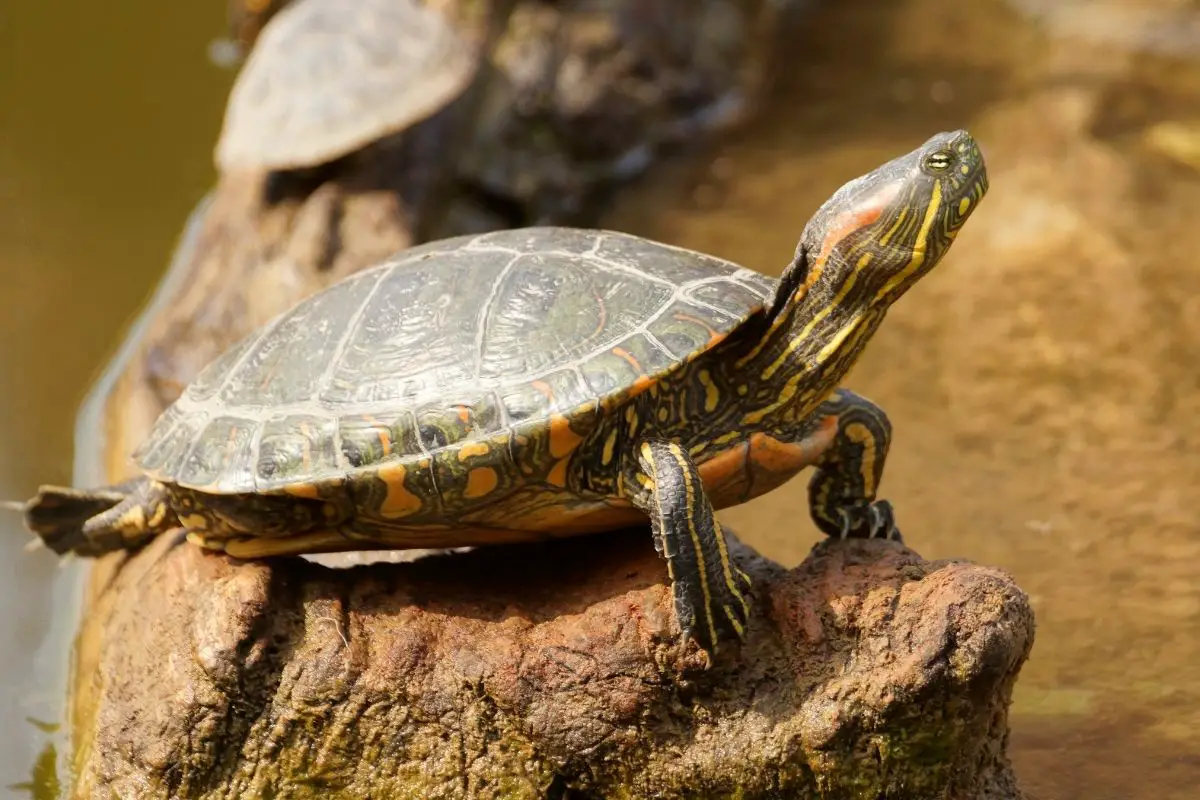
Red-eared sliders are commonly referred to as “sliders” for short. They are native to the eastern coastlines of both the United States and Canada, but they have also been spotted living in Georgia.
These turtles prefer to inhabit sandy beaches and coastal marshes. They feed primarily on small crabs and shrimp. Unfortunately, due to human development, they are frequently caught in fishing nets and killed.
The Red-Eared Slider is a species of freshwater turtle found in Southeast Asia. They are also known as the Asian Pond Turtle or Chinese Softshell Turtle.
These turtles are often confused with the American Box Turtles because they share similar characteristics, such as their shell coloration and size.
Red Eared Sliders are omnivorous reptiles that feed mainly on insects and other invertebrates. They are considered to be good swimmers and burrowers. Their shells are usually reddish-brown in color. The carapace of these turtles has a large number of small tubercles.
Red-Eared Sliders can live up to 50 years. When threatened, they will curl into a ball-like position, protecting their head, neck, chest, and abdomen.
They are a species of turtle that are able to retract their head and arms inside their shell in order to be concealed from predators or any other kind of threat.
The Red-Eared Slider Turtle gets its name from the red ear-shaped markings around the eyes which give it an appearance similar to a slider’s tail.
Not only that, the Red-Eared Slider Turtle is known to be native to a variety of countries located in Southeast Asia, including China, Vietnam, Laos, Cambodia, Thailand, Malaysia, Indonesia, Singapore, Philippines, Taiwan, and Myanmar.
Although interestingly enough, it can also be found in other areas of the world, including both South and North America – including Georgia!
Red Eared Slider Turtles like to live in bodies of water that have a temperature range between 20 °C and 30 °C. It is suggested that they prefer slow-moving waters with little current.
These turtles are typically active during the day; however, they are nocturnal by nature. At the time of writing, this species of turtle is currently considered to be endangered.
Here Are Some Fun Facts About The Red-Eared Slider Turtle
- The average lifespan for a female Red Eared Slider ranges from 25 to 35 years, while males only reach an age of 15 to 20 years.
- These turtles can grow up to 6 inches long and weigh around 1 pound.
- They are oviparous (egg-laying) reptiles.
- The Red-Eared Sliders’ diet consists of aquatic plants, algae, crustaceans, mollusks, insect larvae, fish, amphibians, and annelids.
If you’d like to learn a little more about this totally unique turtle species, then we recommend you check out this book.
The Gopher Tortoise

Gophers are cute little critters, and they happen to call Georgia their home. They burrow underground, destroying soil and vegetation, and creating unsightly holes in lawns. Gophers are native to North America and Asia.
In some parts of the United States, they are considered pests because they eat grassroots and other plants.
Tortoises are reptiles that live in warm climates. There are three types of tortoises: terrestrial (ground), semi-aquatic (freshwater), and marine.
The gopher tortoise is a type of terrestrial tortoise. It lives in areas with sandy soils and low humidity. This makes it very adaptable to its environment and explains why some have found their way to the state of Georgia!
There are two species of gopher tortoise: the northern gopher tortoise and the southern gopher tortoise. Both have been listed as endangered by the U.S. Fish and Wildlife Service.
Even though both types of Gopher have been spotted residing in Georgia, the Northern Gopher Tortoise is the most common.
The northern gopher tortoise has a lifespan of about 60 years. They can grow up to 3 feet long and weigh between 10 and 20 pounds.
Some individuals may reach sizes over 5 feet long and weigh more than 50 pounds. The average lifespan for this species is around 30 years.
The southern gopher tortoise is smaller than the northern one. Their maximum length is 2½ feet, and their weight ranges from 6 to 12 pounds. These tortoises usually live for only 15 years on average.
Here Are Some Fun Facts About The Gopher Tortoise
- They use their front legs to dig tunnels through dirt or sand.
- They will sometimes build nests inside these tunnels.
- When threatened, they curl into a ball.
- They are nocturnal animals, meaning they are active at night.
If you would like to own your very own Gopher Tortoise (or you would simply like to learn a little more about them), then why don’t you consider reading: At Home with the Gopher Tortoise: The Story of a Keystone Species? It’s full to the brim with interesting information, facts, and care insights!
The Cumberland Turtle
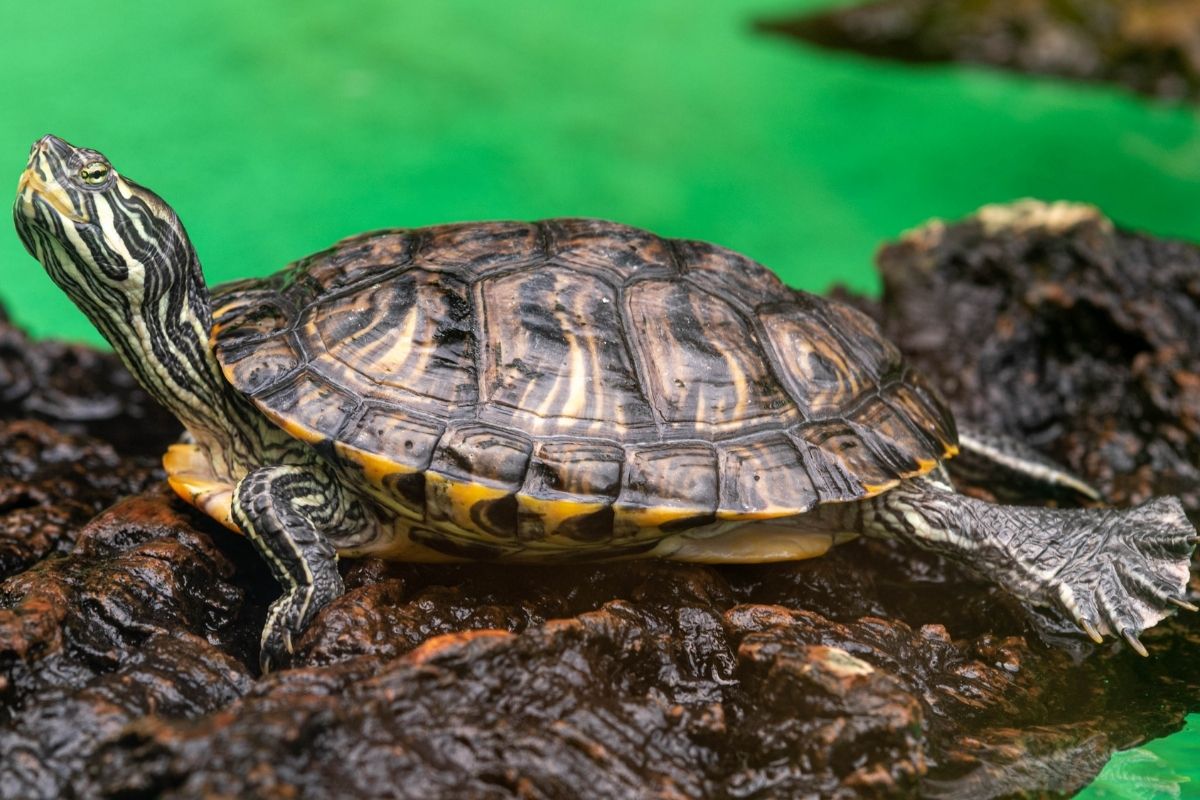
Cumberland turtles are native to North America. They are found in rivers, streams, ponds, lakes, and swamps.
The species was named after Cumberland County, Maine, but these turtles live in a variety of other places across the world and America- including the state of Georgia.
The Cumberland turtle is a large freshwater turtle that can grow up to 13 inches long. It has a brownish-gray shell with black stripes on its back. Its head is gray with a white stripe down the middle of its face.
The eyes are red, and they have a yellow iris. Their legs are dark green and are relatively short and stout.
As for their diet – Cumberland turtles eat small fish, insects, snails, worms, and other aquatic animals. They also feed on plants like algae and roots. Cumberland turtles lay eggs from March through May.
Females lay about 50 eggs per clutch. Eggs hatch in 2 months. Hatchlings are about 4 inches long when born.
Cumberland turtle populations are declining due to habitat loss and overharvesting. Habitat destruction includes clearing land for development, agriculture, logging, mining, and urbanization.
Overharvesting occurs when people remove turtles from their natural habitats.
In some areas, the Cumberland turtle population is protected by law. This means that it is illegal to hunt them or even infringe upon their natural habitat.
During mating season, males will fight each other for territory. If you see one of these fights, please report it to your local wildlife agency.
You might also be interested to learn that Cumberland turtles are one of the most popular kinds of turtles that are kept as pets.
Similar to Gopher tortoises, Cumberland turtles have lovely temperaments and are very sociable. They get on well in groups of more than three turtles, and they are also known to be docile and gentle towards humans, too.
If you are interested in keeping your very own Cumberland turtle as an aquatic pet, you will need to make sure that your turtle is getting plenty of fresh water. Ideally, you should keep your turtle in an aquatic environment.
You should provide at least 5 gallons of water per day. Make sure that the water temperature remains between 70 °F and 80 °F.
Here Are Some Fun Facts About The Cumberland Turtle
- In the wild, Cumberland turtles mate during springtime. They do this because females lay eggs around April and May.
- When they’re not breeding, Cumberland turtles spend time basking in the sun. They bask for about two hours every day.
- A female Cumberland turtle lays approximately 60 eggs per year. Each egg weighs about 1/4 ounce.
- After hatching, hatchlings remain inside their shells until they reach sexual maturity. At this point, they emerge from their shells and begin to look for food.
- Female Cumberland turtles can live up to 30 years old. Males tend to live shorter lives.
- Cumberland turtles can swim underwater for up to 10 minutes at a time!
- Cumberland turtles are omnivores, meaning that they eat both plant and animal matter.
If you’re currently considering owning your very own Cumberland Turtle, then why don’t you consider reading the book, How to Care for Pet Turtles Like an Expert?
This book is positively full to the brim with information about how to care for your own turtles. It’s an excellent resource for anyone interested in turtles without prior knowledge of how to care for them.
The Spotted Turtle
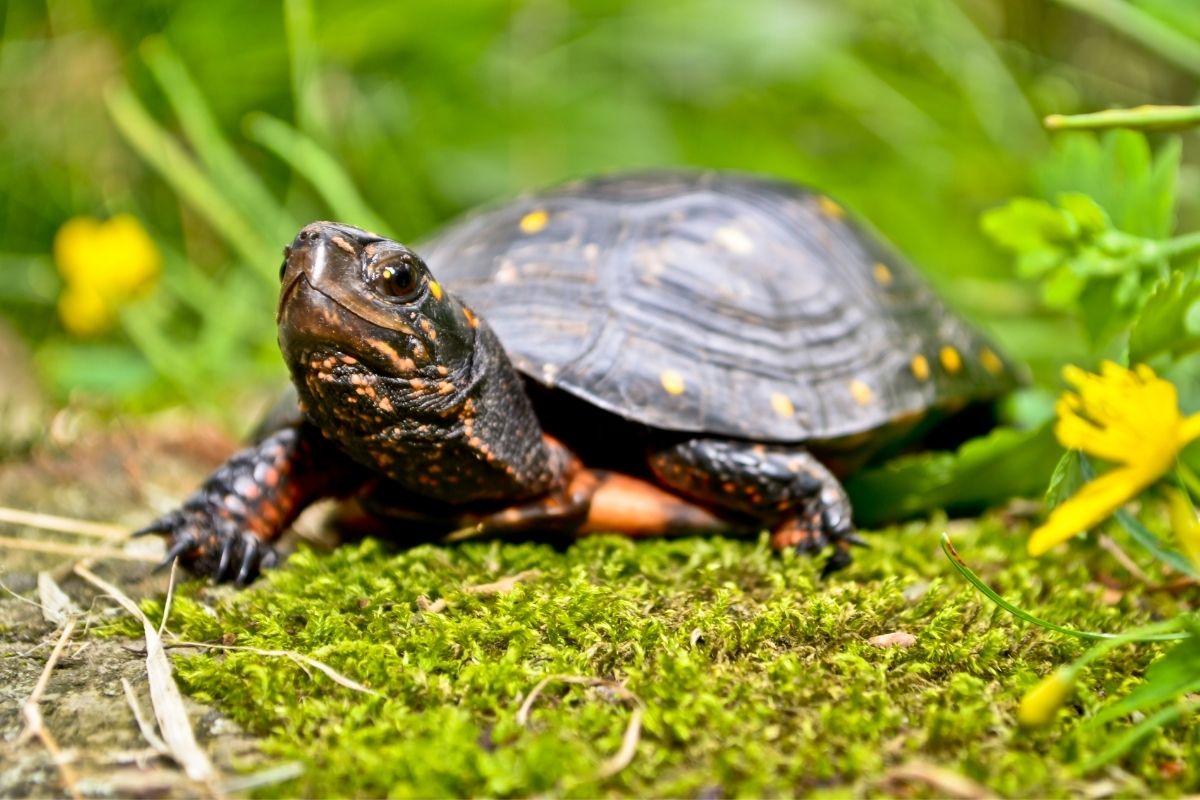
Spotted turtles are a species of turtle found throughout the United States and Canada.
They are also known as the eastern box turtle or simply the box turtle. The name comes from their distinctive markings, which include spots on their backs and shells.
Spotted turtles are native to North America and are considered endangered due to habitat destruction and hunting. They are also threatened by invasive species such as the Burmese python.
Spotted turtles are slow-moving animals that are often confused with tortoises.
Their shell size ranges between 12 inches and 20 inches. They are omnivorous and feed on insects, worms, snails, slugs, frogs, fish, and other invertebrates.
The spotted turtle has been around for millions of years. It was first discovered in 1831 when an American naturalist named John Cassin came across one while exploring the Appalachian Mountains.
He described it as having “a back like a map” and noted its distinct markings. The next year, he published his findings on the animal in a book called A History of the Earth and Animated Nature.
In addition, the spotted turtle is one of the oldest living reptiles on earth. Scientists have estimated that they lived up until 10 million years ago.
In fact, fossils of these creatures have been found all over the world, although they are native to the state of Georgia and are often seen residing there.
Here Are Some Fun Facts About The Spotted Turtle
- The spotted turtle can be distinguished from other types of turtles because of its unique patterned shell.
- These turtles are not actually turtles at all but rather tortoises. Tortoises are much larger than turtles and have a rounder shape.
- The spotted turtle is sometimes referred to as the eastern box turtle because of its distinctive markings.
- The spotted turtle is a carnivore. This means that it eats meat. Carnivores eat meat.
- Spotted turtles are omnivorous, meaning they eat both plants and meat.
The Green Sea Turtle

The Green Sea Turtle (Chelonia mydas) is a species of marine turtle found in tropical waters around the globe. However, they are considered to be native to Georgia – believe it or not!
They are also known as Hawksbill Turtles or Loggerhead turtles. These turtles are large, heavy-bodied reptiles with long necks and tails.
They are carnivorous animals that feed primarily on jellyfish, mollusks, crustaceans, fish, and other invertebrates. Their shells are covered with bony plates called osteoderms.
The female lays between 100-200 eggs at a time which can weigh up to 5 pounds each. The female turtle will then cover them in the sand for protection.
If the eggs are not protected from predators, they will be eaten by birds, raccoons, rats, dogs, cats, etc.
When hatched, the baby turtles measure approximately 8 inches in length. They have no teeth until they reach adulthood.
The Green Sea Turtle has been listed as an endangered species since 1970 due to overfishing. In fact, its population is declining rapidly.
It is estimated that there are only 1 million left in the wild. This means that every year, fewer and fewer hatchlings survive to become adults.
Today, many people believe that this turtle should be considered extinct. However, it is still possible to see these beautiful creatures in captivity.
In order to protect the Green Sea Turtle, we must first learn more about their habits and environment. We need to find out what causes their numbers to decline so that we may help them.
Here Are Some Fun Facts About The Green Sea Turtle
- The average lifespan of a Green Sea Turtle is 60 years.
- A single egg weighs about 4 ounces.
- The Green Sea Turtle’s shell is made of calcium carbonate.
- Its heart beats about 300 times per minute.
- It breathes through gills located behind its head.
If you want to discover more about the Green Sea Turtle, we encourage you to read Sea Turtles: A Complete Guide to Their Biology, Behavior, and Conservation.
It’s a great read, and Amazon even allows you to take a sneak peek at it so that you can get a feel for what it includes before you purchase it!
The Hawksbill Turtle
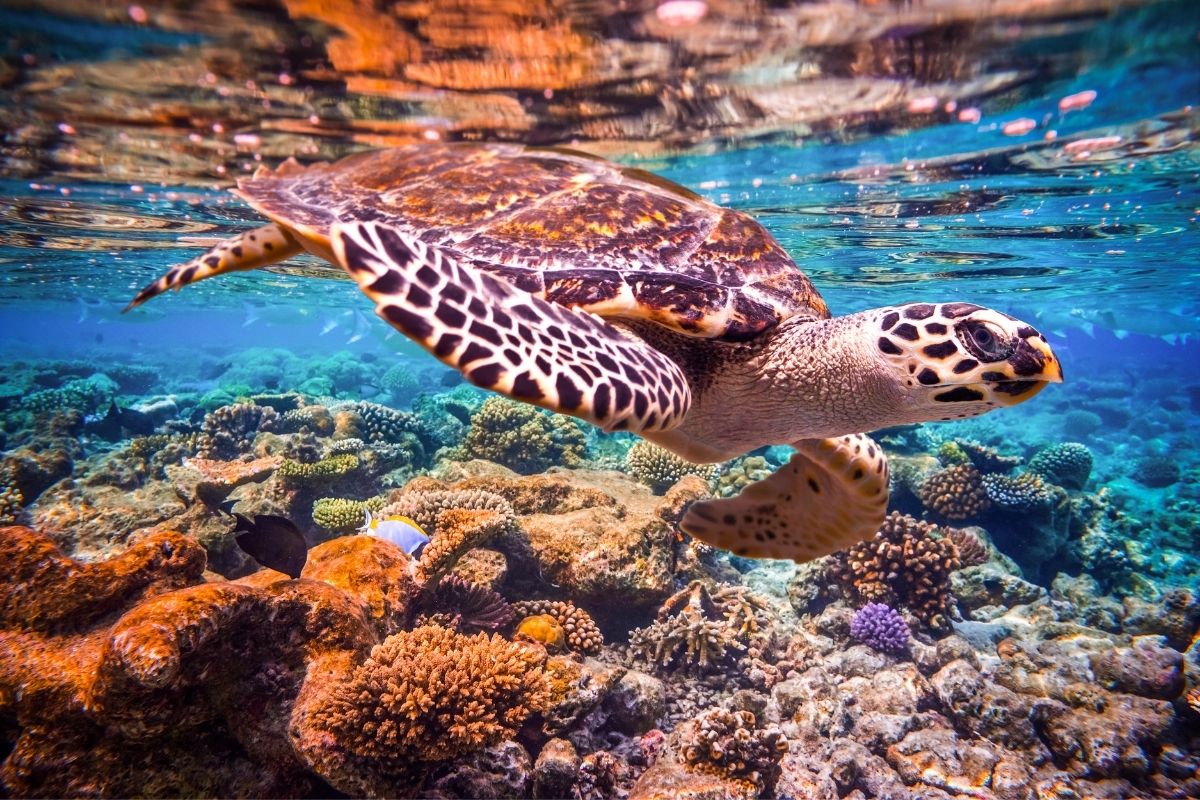
Hawksbill turtles are large marine reptiles found in tropical waters around the globe, but a great majority of them currently reside in Georgia.
The hawksbill sea turtle has a distinctive shell shape, with a long neck and head, short legs, and a broad tail. These turtles are often confused with loggerheads because they share similar characteristics.
Due to its declining population, this species is listed as vulnerable under the IUCN Red List of Threatened Species. This is mainly caused by habitat destruction and poaching.
Hawksbill turtles have been hunted for their meat, eggs, and shell. The leather created from their shells was used to make shoes, belts, and other items.
In the past, fishermen would hunt these turtles during migration season. Today, it is illegal to capture them.
Hawksbills can live up to 100 years old. Females lay about 60-80 eggs every year. Hatchlings weigh between 5 and 10 pounds and grow quickly. After hatching, they will stay near the nest until they reach sexual maturity at age 3-5 years.
Habitats where this species lives include coastal areas such as mangroves, coral reefs, seagrass beds, estuaries, rivers, lakes, ponds, and wetlands – so it should come as no surprise to hear that this species of turtle loves residing in the many different wetlands, beaches, and lakes that Georgia offers!
It prefers shallow water but can be found deeper than 30 feet (9 meters).
Here Are Some Fun Facts About The Hawksbill Turtle
- The name “hawksbill” comes from the fact that when the female lays her eggs, she uses her bill to dig a hole into which she deposits the egg. She then covers the hole with sand and leaves it alone. When the hatchling emerges, it is already covered in a hard carapace.
- Hawksbills are considered one of the most intelligent animals on Earth.
- The average lifespan of a male hawksbill is 50 years, while females live an average of 70 years
The Alabama Map Turtle

The Alabama Map Turtle was named after its resemblance to a map of the state of Alabama. It has been classified as an endangered species by the State of Alabama because it is threatened with extinction due to habitat loss.
This turtle also lives in a variety of other habitats and regions across the globe, including states, including Georgia.
The Alabama Map Turtle lives in rivers, streams, swamps, ponds, lakes, marshes, and coastal areas. They can be found from sea level up to about 1,000 feet above sea level.
Their diet consists mainly of plants, but they will sometimes eat small amounts of food, such as worms, insects, crayfish, and crabs.
They do not hibernate during the winter months. During this time, they may seek shelter under logs, rocks, or other objects.
In springtime, they begin to mate. Females lay clutches of between 25 and 100 eggs. These eggs hatch within two weeks. Hatchlings measure approximately 2 inches long and weigh only one-tenth of an ounce.
After hatching, the young turtles make their way to water bodies, where they spend most of their time until they reach sexual maturity at around three years old.
The Alabama map turtle can be identified by its distinctive pattern of dark stripes on a light background. This pattern is unique to each individual turtle – just like in the way our fingerprints are entirely unique to us.
The Alabama map turtle also has a super friendly temperament, and it is usually very easy to approach them.
However, keep in mind that this particular species of turtle is not usually kept as a pet due to the fact that they naturally like to live in freshwater environments, which means that they are better off in the wild.
Here Are Some Fun Facts About The Alabama Map Turtle
- The average lifespan for this species is 10–20 years.
- There are currently less than 5,000 individuals left in existence today. This is mainly due to its natural habitat becoming damaged or destroyed.
- The Alabama Map Turtle is listed as an endangered species by both the U.S. Fish & Wildlife Service and the Alabama Department of Conservation and Natural Resources.
- The Alabama map turtle is native to North America, including Georgia and Alabama – hence the name!
As a side note, if you are interested in learning more about this unique turtle species, we recommend you check out this book: The Map Turtle and Sawback Atlas: Ecology, Evolution, Distribution, and Conservation.
It has plenty of helpful information about the Alabama Map Turtle within it.
The 3-Striped Mud Turtle
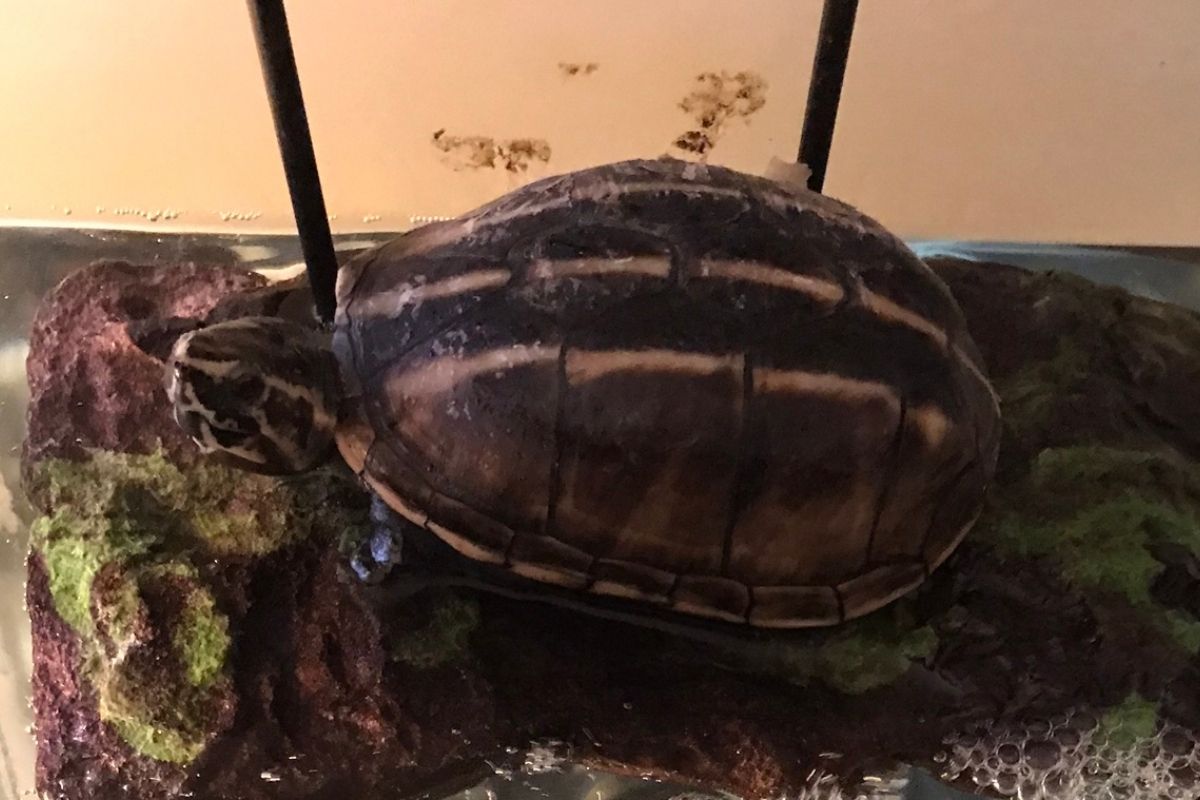
There are over 500 species of turtles, but only three of them are considered true freshwater turtles. These include the American box turtle, the Chinese softshell turtle, and the 3-striped river turtle. What makes these turtles unique?
Another species of turtle that resides on the many beaches of Georgia is the 3-striped mud turtle. The 3-striped river turtles (Podocnemis expansa) are found in South America.
They live in slow-moving rivers and the ocean where they spend the majority of their lives – although they do spend some time on land, primarily to mate and nest their eggs. They eat aquatic plants and insects and breed every two years.
This turtle has a very interesting life cycle. Its eggs hatch from the nest and float downriver until they reach the ocean.
Once at sea, the young turtles swim toward warmer waters and eventually settle into the open ocean. This migration takes place during the summer months.
While on land, they will usually reside in freshwater living environments. Still, they are mostly seen living near beaches due to the fact that this particular breed of this turtle is primarily aquatic.
The 3-striped mud turtle can be identified by its distinctive markings. It has an orange head with black stripes running through it.
It also has a white stripe along each side of its shell. When the turtle reaches adulthood, it sheds its skin and grows new ones.
Here Are Some Fun Facts About The 3-striped Mud Turtle
- The 3-striped mud turtles have been known to live for up to 50 years!
- In order to survive, the 3-striped turtles must stay warm enough so that they don’t freeze when temperatures drop below freezing.
- The 3-stripe turtles are one of the few turtle species that can actually walk backward!
The Eastern Mud Turtle
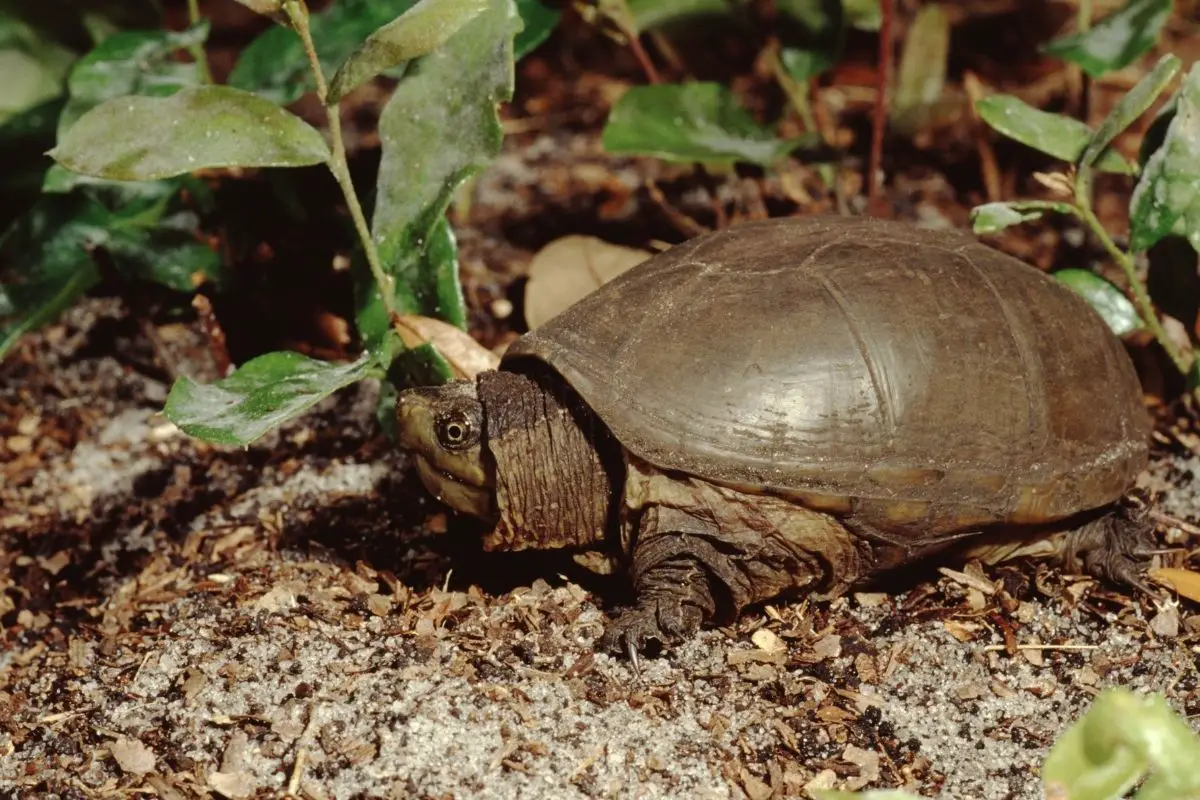
The Eastern Mud Turtle (Pelodiscus Sinensis) is a species of freshwater turtle found in China, Vietnam, Laos, Cambodia, Thailand, Myanmar, India, Bangladesh, Nepal, Pakistan, Sri Lanka, Indonesia, Malaysia, Singapore, Brunei Darussalam, East Timor, Papua New Guinea, Australia, and New Zealand.
It has been estimated that over 50 million individuals are currently living in captivity worldwide. This makes it one of the most widely kept reptiles.
In addition, it is also one of the longest-lived animals on Earth. The average lifespan for this species is about 100 years.
Eastern Mud Turtles can be identified by their dark brown/black shell containing vibrant and eye-catching yellow stripes or spots cascading down across the shell to the edges.
They have a long neck and head, short legs, and webbed feet. Their eyes are located at the top of their heads.
They are omnivorous, eating both plant and animal matter. However, they prefer to feed on aquatic plants such as water lilies and duckweed.
When they need to eat meat, they will go after fish, frogs, insects, small mammals, birds, and even other turtles due to their larger size.
They are very active during the day and come out of the water when it gets too hot. During the night, they return to the water and sleep until it’s time to get up again.
During the breeding season, males will fight each other for territory. Females lay eggs in shallow water where the temperature is between 20-25 degrees Celsius.
Once the eggs hatch, the female leaves her nest and returns to the water. In the wild, these turtles spend most of their lives in rivers, ponds, lakes, swamps, and marshes.
Here Are Some Fun Facts About The Eastern Mud Turtle
- The first sighting of this turtle was recorded by Linnaeus in 1758.
- Its scientific name means “Chinese softshell turtle.”
- The Chinese call it “Jiaolong.”
The Mississippi Mud Turtle
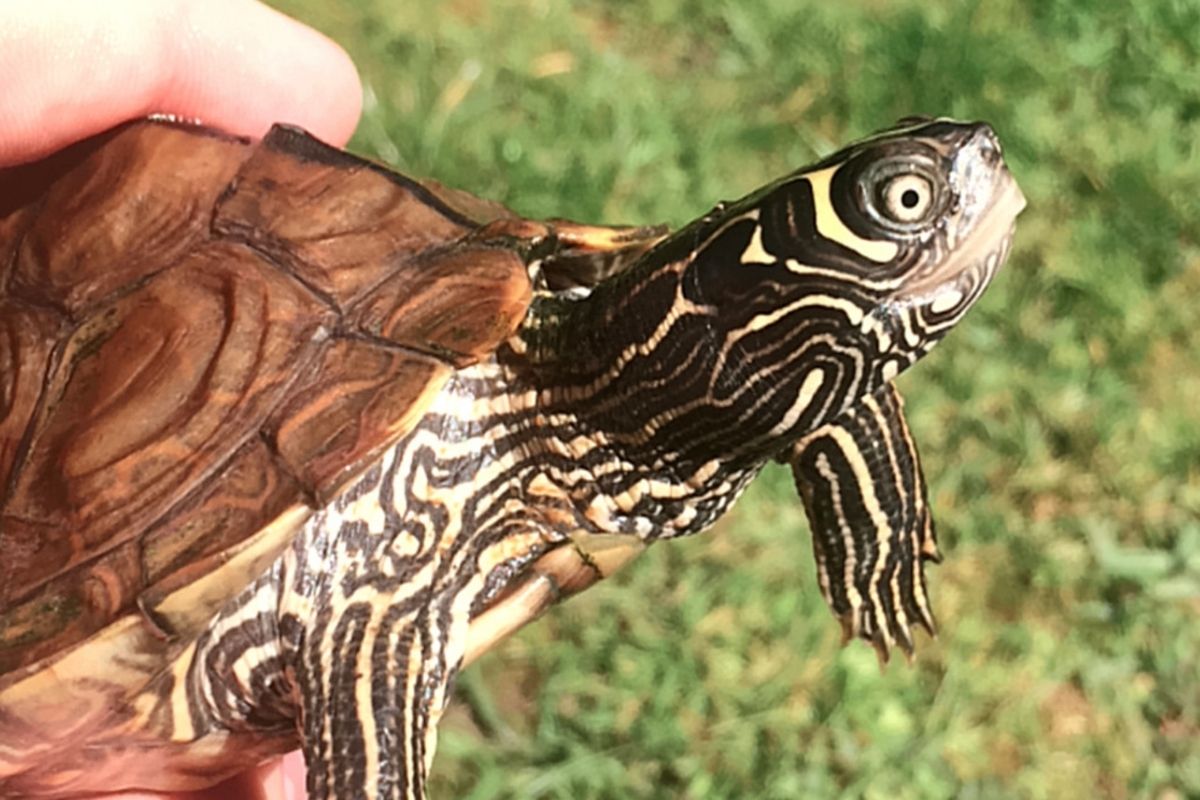
Mississippi turtles are native to the Mississippi River basin. They are also known as mud turtles or river terrapins! Their adorable and funny name comes from the fact that they have made a habit of living in muddy areas near rivers.
Besides these living environments, this particular species of turtle also likes to live in freshwater living environments, where there is plenty of flowing water and lots of yummy vegetation for them to feast on.
The Mississippi Turtle was listed as endangered in 1973. This species has declined because of habitat destruction and pollution. In addition, they are often caught by fishermen who sell them for food.
At the time of writing, lots of steps are being taken by the state of Georgia to help counteract the declining population numbers of this loveable turtle species, including ethically using female Mississippi mud turtles to conserve their eggs while in captivity.
This species is found only in the United States, and it is prevalent in the estate of Georgia. The Mississippi turtle can be easily distinguished from its close relative, the Alabama mud turtle, which is also called the “red-bellied” turtle.
It is much smaller than the red-bellied turtle, and it lacks a distinctive black band around its neck. Both species are very similar in appearance, but they differ in size and coloration.
Both the Mississippi and Alabama mud turtles are omnivorous, meaning that they eat both plant and animal matter.
However, the Mississippi turtle is more likely to eat plants, whereas the Alabama mud turtle will eat animals such as fish, crayfish, and frogs.
Both the Mississippi and Alabama mud turtles prefer to live in freshwater, so they do not need to go far to find their food source.
The Mississippi turtle lives in ponds, lakes, swamps, streams, and ditches. Its diet consists mainly of aquatic vegetation and small invertebrates. These turtles can grow up to three feet long, and they weigh about one pound.
These creatures are active during the day, and they spend most of their time basking in the sun. During the winter months, they hibernate in underground burrows or under logs and stumps.
When temperatures rise above freezing, they emerge from their burrow and bask until spring arrives in the warm sunshine. These turtles can often be seen basking in the sand, mud, and even foliage.
Here Are Some Fun Facts About The Mississippi Mud Turtle
- They are nocturnal, spending the daylight hours hiding in holes or under logs.
- Their shells are greenish-brown with yellow stripes.
- They have five toes on each foot.
- They lay between 50 and 100 eggs at a time.
- They are considered an invasive species in many parts of the world
The Northern Diamondback Terrapin
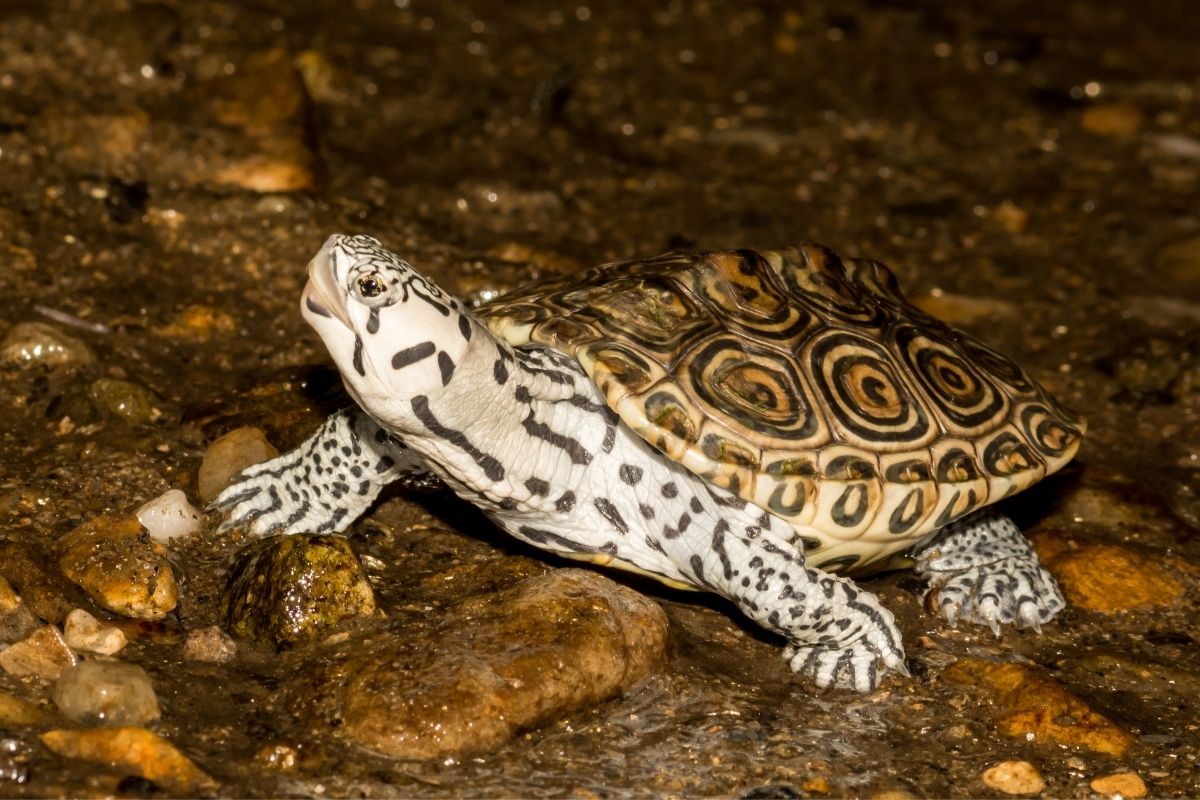
This turtle species was once found throughout the state of Florida, but today they are also found along the coast from Tampa Bay southward to Key West and other areas of the USA – including Georgia. This particular species of turtle prefers warm water and sandy beaches.
They are carnivores, feeding primarily on crabs, shrimp, worms, mollusks, and other invertebrates. Their shells are very thick and heavy, weighing anywhere between 20 and 40 pounds.
However, it is also worth noting that the Northern Diamondback Terrapin is an opportunistic hunter, which means that it will often be seen digging holes in the ground in search of insects when food is scarce – and will even eat plants and other vegetation when food supplies are particularly low.
These turtles were originally native to North America but have been introduced into many parts of the world.
In fact, they have now been considered to be an invasive species in Australia, New Zealand, South Africa, Japan, China, England, Ireland, Scotland, Germany, Spain, Italy, France, Portugal, Belgium, and many other places around the globe.
The Northern Diamondback Terrapin gets its unique name from the diamond-shaped pattern that runs down its back.
It is believed that this shape helps protect them against predators such as alligators, while also making them more easily distinguishable from other types of turtle species that they cohabitate with.
In addition to all of the above, these beautiful turtles will usually grow to be about two feet long, although in some rare instances, they might be even longer than this.
Interestingly, females are usually larger than males, which is not something that is overly common among turtles. Males reach sexual maturity at about 6 months old, and females at 12 months old.
To follow, female terrapins lay eggs every spring. Each female lays approximately 100 eggs per year. She will lay her eggs in shallow nests dug up by the male. These nests can range in size from just a few inches deep to several feet deep.
Once the eggs hatch, the mother will stay close to the nest until the babies are ready to leave. After the babies hatch, she will carry them around for several weeks before letting them go.
Here Are Some Fun Facts About The Northern Diamond Terrapin
- The average lifespan of a Northern Diamondback Terrapins is about 30 years.
- The average weight of a Northern Diamondback Turtle is about 15 lbs.
If you’re interested in learning more about the Northern Diamond Terrapin, why don’t you check out this book? It’s a great place to start and has plenty of information about other types of turtles, too.
The Eastern River Cooter
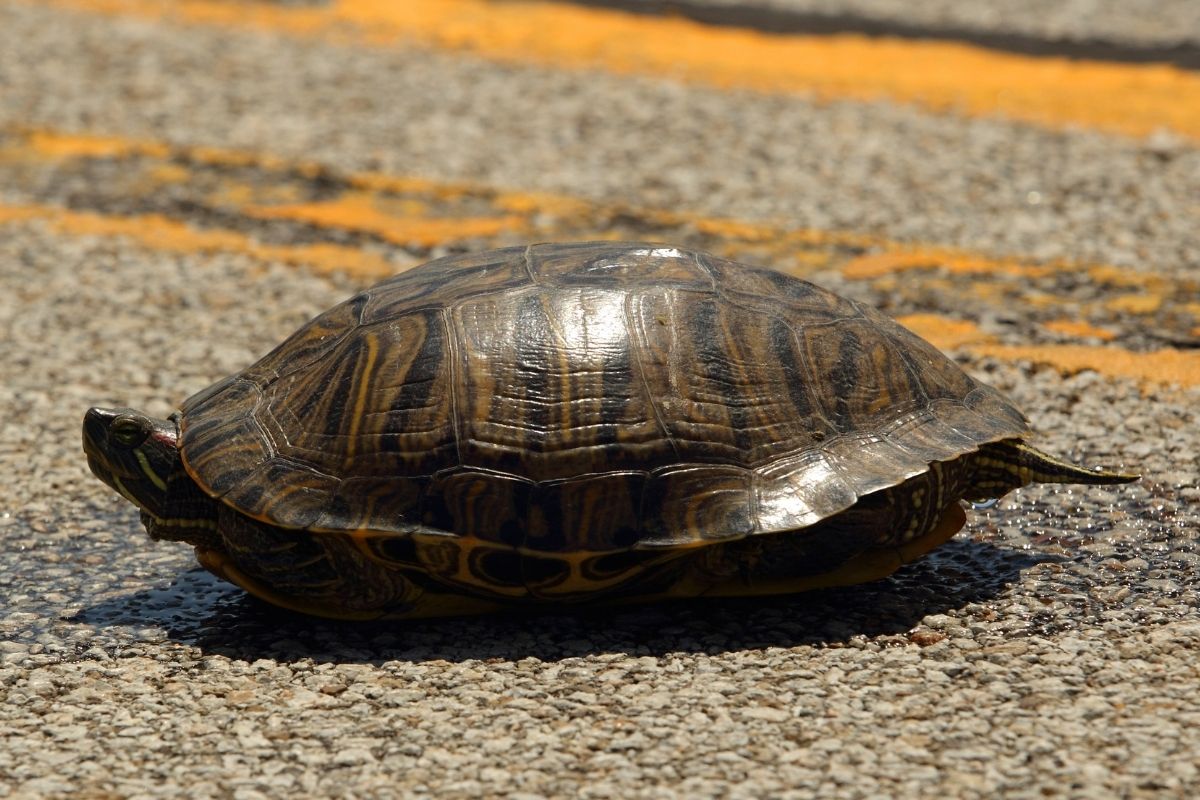
The Eastern River Turtle is a type of freshwater turtle. These turtles are native to Southeast Asia and they are also sometimes called the Asian softshell turtle.
At the time of writing this, the Eastern River Turtle has been classified as an endangered species by the IUCN Red List since 1996. This classification means that it is at risk of extinction in the wild.
The Eastern River Turtles are most commonly seen in Thailand, Cambodia, Laos, Vietnam, Malaysia, Indonesia, Singapore, Brunei Darussalam, Myanmar, China, and India.
However, in recent years, the turtle has been seen more frequently in the USA, including in Georgia.
Eastern River Turtles have long been used for food and traditional medicine.
In some parts of Asia, people still use them as pets. However, due to their endangered status – the majority of them nowadays are kept in captivity to help get population numbers to a safe amount.
Eastern River Turtles can grow up to 1 meter (3 feet) in length. Their shells are usually greenish-brown with black stripes.
They have small heads, large eyes, and short legs. Their diet consists mostly of fish, crustaceans, insects, worms, mollusks, and snails. They lay eggs every year between May and June.
An Eastern River Turtle is easily identified because its shell is very thick. These turtles are also usually brownish with black stripes on each side.
Here Are Some Fun Facts About The Eastern River Cooter
- The Eastern River Turtle’s name comes from the fact that it lives near rivers.
- The Eastern River Turtles’ habitat includes both fresh and saltwater.
- It is one of the largest freshwater turtle species in the world!
The Florida Red-Bellied Turtle

The Florida Red-Bellied Turtle (Pseudemys rubriventris) is a species of freshwater turtle native to the southeastern United States. However, they can now be found all across the world – including Georgia.
They love freshwater habitats and are found in rivers, streams, lakes, ponds, and swamps.
They are also known as the Florida Mud Turtle or the Red-Bellied Turtle. These turtles live in warm water areas where they spend their time basking in the sun.
They eat algae and other plants growing in shallow waters. The females lay eggs on land near water.
They can be distinguished from other similar-looking turtles by their large size, dark coloration, and lack of a yellow stripe along the side of their shell. Their shells have five ridges that run down the length of their carapace.
These turtles need clean, fresh water with no contaminants such as pesticides or fertilizers.
If you find your turtle has been exposed to these types of chemicals, it could be sick or dying. You may want to remove it from its habitat until you know more about what happened.
These turtles are very sensitive to changes in temperature and humidity levels.
When temperatures drop below 60 degrees Fahrenheit, they will go into hibernation. Turtles can survive without food for up to two months if they are not disturbed.
Contact your local wildlife rehabilitator immediately if you notice any signs of illness. It’s important to keep an eye out for injured or sick animals because they can become aggressive when they feel threatened.
Here Are Some Fun Facts About The Florida Red-Bellied Turtle
- The Red-Bellied Turtle is a species of freshwater turtle that mainly lives in North America, and it is also known as the Florida Turtle or the Florida Box Turtle. The Red-bellied Turtle is one of only two turtles in the world that can be found in both freshwater and saltwater environments.
- It has been estimated that there are over 2 million individuals living in the wild today. In fact, this number is growing every year. This is because they have become so popular as pets.
- They are one of the most domesticated of all turtles, as they are very sociable and get on well with humans.
If you would like to learn more about the different types of turtles that originally came from Florida, then we recommend that you take a look at this book.
The Stripe Necked Musk Turtle
The striped neck musk turtle (Sternotherus niger) is a species of freshwater turtle native to Africa. They are also known as the African river turtle or the black-necked turtle. The name comes from the distinctive stripes along their necks.
The Striped Neck Musk turtle likes to reside in freshwater habitats where they can find a stream of flowing water.
Originally, the Striped Neck Musk turtle could be found living near rivers, streams, swamps, and other wetlands throughout sub-Saharan Africa – which is a location of the world where this species of turtle is native.
However, this species of turtle is extremely adaptable, which means that they can live in a variety of environments. With that being said, their range extends from Senegal in the west through Ethiopia and Sudan to South Africa.
In Kenya, they live in Lake Victoria and the Athi River. They also reside in various areas of both South and North America, with Georgia being at the very top of that list.
They are herbivores that eat grasses, sedges, leaves, roots, fruits, seeds, flowers, aquatic plants, algae, and insects. They prefer to feed on vegetation that grows close to the ground.
Their diet consists mostly of plant matter, but they will occasionally consume small amounts of fish and crustaceans. They have been observed eating snails, frogs, and even small mammals.
As for reproduction, they lay eggs between April and June. These eggs are laid in nests that are made out of mud, sticks, and leaves. This species of turtle has an average lifespan of 15 years.
Here Are Some Fun Facts About The Stripe Necked Musk Turtle
- They live for around 15 years in the wild.
- The Stripe Necked Musk turtle is native to sub-Saharan Africa.
- They like to live in freshwater habitats.
The Bottom Line
There we have it! You’ve made it to the end. Now that you have taken the time to read through this ultimate guide, we’re hoping that you now have a much greater understanding of the various types of turtle species that are native to Georgia.
To sum up, all that we have talked you through above, even though there are a great many different types of turtles currently living in Georgia (and the exact figure is expected to rise over the coming years) each turtle species is unique and different from the next in its own individual way.
Hopefully, besides learning about these different species of turtle, we hope you can see how each one deserves to be protected, and their natural habitats maintained in order to ensure their survival.
If you enjoyed reading our article, then why don’t you consider giving this page a bookmark? That way, if you ever want to come back and refresh your memory on the different types of turtle species that currently live in Georgia – you’ll know exactly where to find this guide.
Before you click off, don’t forget to take a peek at our FAQ below, where you’ll find the answers to some commonly asked turtle-related questions. Thank you for reading!
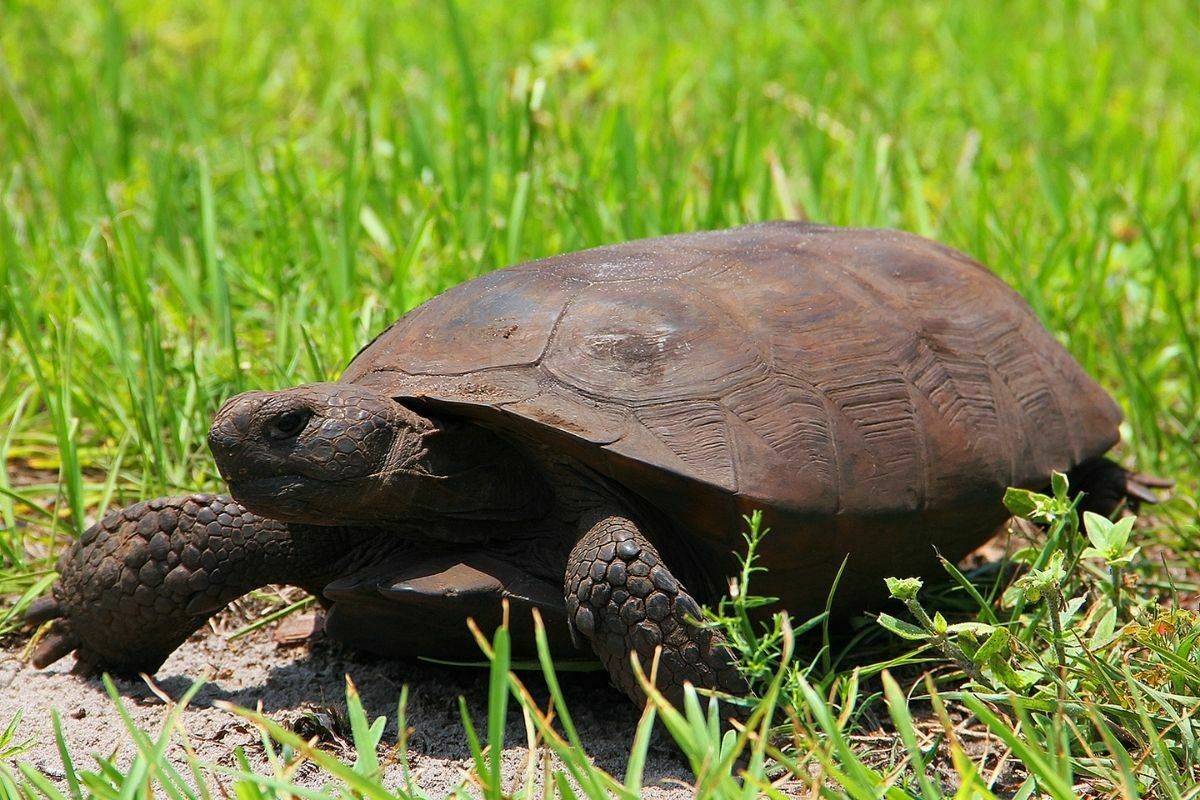
Frequently Asked Questions
So, now that you have learned a little bit more about all the various types of turtle species that can currently be found residing in the state of Georgia (can you believe there are 40?), we are now going to be taking the time to answer some of the most commonly asked questions surrounding turtles.
Keep reading to see if there are any questions here that you’ve wanted the answer to:
What Are The Different Types Of Turtles?
There are three main categories of turtles: marine, freshwater, and terrestrial. Marine turtles are those that live in saltwater oceans, rivers, lakes, bays, estuaries, and coastal waters.
These include sea turtles, river turtles, and loggerhead turtles. Freshwater turtles are those that live within freshwater bodies such as ponds, streams, lakes, and marshes.
Terrestrial turtles are those that live on land, including the alligator snapping turtles, box turtles, cooters, common snapping turtles, and more.
It’s important to note that there are both land turtles and sea turtles. Land turtles are found in dry environments, whereas sea turtles prefer saltwater. Both types of turtles have webbed feet.
Regardless of what type of category a turtle falls under, all turtles will be kept inside a nest (usually concealed underneath the sand or even in holes if they live on land) by a female turtle until they are ready to hatch.
How Big Are Turtles?
Turtles vary in size depending on the type of animal. For example, the common snapping turtle is about 4 inches long and weighs around 1 pound.
On the other hand, the giant leatherback turtle can grow up to 12 feet long and weigh more than 2 tons.
Where Do Turtles Live?
Turtle habitats range from tropical rainforests to deserts. Turtles can be found anywhere between the equator and the poles.
Although, the majority of turtles will typically opt to live in areas with access to water (such as a lake or the ocean) and somewhere that contains plenty of vegetation.
Where Do Turtles Mate?
Mating occurs either during the spring or summer months. Males usually find mates using their sense of smell. Females choose males based on their physical appearance and behavior.
Once a female has chosen her partner, she lays her eggs in a nest. She then covers them with soil or sand – depending on what type of turtle it is and what environment she happens to be in at the time of burying her eggs.
Are Turtles Intelligent?
Yes! There is plenty of evidence that suggests that turtles are able to think logically and solve problems!
Not only that, but there has been plenty of evidence to suggest that turtles are sentient beings, too. If you weren’t already aware, sentient is the term used to describe animals who feel pain and pleasure.
In other words, emotion. Turtles have been recorded to show feelings of emotion (including happiness and pain) alongside other animals.
Interestingly enough, a study published in 2004 by researchers at Duke University claimed that green sea turtles use tools to help dig holes to lay eggs.
The study found that when given a choice between using a tool or digging manually, the turtles always chose the tool as it was quicker and easier.
This shows that they were aware of what the tool could do and how it would help them complete their task more easily.
This is extremely interesting and shows that turtles have the ability to not only decipher between objects but also have the ability to use critical thinking skills to determine which object would be the most effective in helping them to conceal their eggs safely in the sand and out of view of any dangerous predators that might try to eat them!
In addition to this fascinating study, there was another study that was published in 2013 that showed that when a ball was placed on the ground in front of a hungry turtle, the turtle tried to explore the ball to see if there was any food inside it.
This suggested to researchers who were studying the turtles that the turtles involved in the ball study could determine in their minds that there might have been something valuable inside the ball…aka food!
This is also extremely interesting, as it suggested to researchers that turtles have the ability to use problem-solving skills to try to reach an end goal, which in that instance, was to find food because they were hungry.
Alongside all of the above, turtles are also very adept at surviving in the wild, which shows how intelligent they are.
In order to survive (especially for 100 years or more), turtles need not only to make sure that they can adapt to different environments but that they can also learn from these changes and adjust accordingly.
As such, turtles are known to be quite smart and capable of solving problems.
How Do I Care For A Turtle?
Feeding
Turtles need to eat about 2-3 times per day. You can feed your turtle with vegetables such as lettuce, spinach, carrots, broccoli, celery, peas, corn, or any other vegetable that is easy to digest.
Make sure your turtle eats all of its food before putting it back into the aquarium. This will help prevent digestive problems.
Water Quality
Clean tap water is fine for most freshwater turtles. However, if your turtle lives in a pond, ensure no chemicals are in the water. Also, ensure that the water temperature is not too hot or cold. It should be between 65 °F and 85 °F.
If you want to be extra safe, we recommend you consider using a water conditioner designed for reptiles, such as this one.
Exercise
Turtles like to exercise by swimming. You can provide your turtle with an underwater treadmill so that he/she can swim without getting tired.
Heat
Turtles need heat to regulate their body temperatures. Provide your turtle with a basking spot where it can bask in the sun. Basking spots should be 30 °C or higher.
If you are planning on owning a turtle of your own, we recommend you give it a dedicated basking spot where it can relax and soak up the sunlight.
Raised basking spots that provide turtles with a vantage point are great options to consider, such as this one.
Shelter
Turtles need shelter from predators, which means that they will naturally seek out places to hide. You can place your turtle inside a terrarium. Alternatively, you can use a plastic tub filled with sand.
Lighting
Turtles need plenty of direct light to visibly see as they don’t have the best eyesight. Make sure that your turtles can go out into the sunlight if they so desire while also ensuring that they have a safe, dark environment where they can rest, feel safe, and keep eggs.
Toys
Some species of turtles enjoy playing with toys. You can buy some turtle toys online. These include balls, sticks, ropes, and tunnels.
Health
Turtles have different health issues depending on what type of turtle they are.
Suppose you are planning on owning a turtle (or even turtles) of your own. In that case, you should be sure to familiarize yourself with the potential health problems that your particular species of a turtle might experience, as well as ensure that you regularly visit the vet for check-ups to make sure that everything is okay.
Diet
Turtles need a balanced diet. You can give your turtle foods such as fruits, vegetables, fish, meat, and bread.
Even though most turtles are best left in the wild, there are some instances where you might be able to own your own if you have the appropriate facilities to keep them without impacting their natural living preferences and habitat.
By making sure that you are following the tips that we have given above, as well as making sure that you are regularly consulting your vet – you should find that you are able to care for your very own turtle successfully!
We also recommend that you do as much reading as possible if you plan on becoming an aquatic turtle owner–we think this book is a great place to begin.
What Do Turtles Like To Eat?
Great question! As we are sure you’ll have already discovered by looking through the list of the main species of turtles currently residing in Georgia, most turtles are omnivores.
This means that they eat both plants and animals – depending on what is available in their environment. Their diets consist mainly of insects, worms, snails, small fish, crustaceans, frogs, mollusks, and seeds.
If you are planning on owning some of your very own turtles, we strongly recommend that you do some research to discover what type of food your specific type of turtle likes to eat, as this will help ensure that your turtles are given the correct diet.
In addition, if you are unsure about what your turtle should be eating, we strongly suggest you seek guidance from a vet or wildlife rehabilitator.
Where Can I Get My Turtle Food?
You can purchase your turtle’s food at pet stores. Many websites sell turtle food that you can order online and directly deliver to your doorstep!
The majority of these websites also allow you to purchase your orders in bulk for a more affordable wholesale price – which makes this option a great choice to consider for anyone who owns an animal sanctuary or similar organization, as this will help to ensure that your costs are kept as low as possible.
One of the best places that you can purchase turtle food is Amazon! Amazon sells a variety of different turtle food designed for both land and aquatic turtles. Another great place to purchase your turtle food online is via Chewy.
So, with that being said, if you’re planning on becoming the proud owner of a turtle, then we recommend making sure that you have a variety of freeze-dried critters, treats, and food sticks that you can give to your turtle to make sure that they are enjoying a healthy, nutritious diet.
What Types Of Food Should I Feed My Turtle?
As we have already briefly touched upon in a previous question, many different kinds of food available on the market today will be well-suited to a turtle’s diet.
Some of these include; live mealworms, frozen crickets, freeze-dried crickets, freeze-dried mealworms, freeze-dried shrimp, freeze-dried earthworms, freeze-dried bloodworm larvae, freeze-dried fruit flies, freeze-dried wax moth larvae, freeze-dried cockroaches, freeze-dried beetles, freeze-dried grasshoppers, freeze-dried cicadas, freeze-dried black soldier fly larvae, freeze-dried brine and plenty more.
Alongside this, you can also give turtles a variety of different treats and snacks – the Zilla Turtle Chasers are pretty popular and worth checking out.
If you’re stuck searching for freeze-dried options to feed your turtle – Chewy has some great options, including crickets, mealworm, and even shrimp.
In addition to all of the above that we have just mentioned, it is also worth noting that the majority of turtles absolutely love to eat fresh fruits and vegetables…so make sure that you have plenty of those on hand, too!
How Long Can Turtles Live?
Turtles are known for their longevity regardless of what type of turtle they are.
As we’re sure you might very well be aware, turtles have the ability to live (on average) much longer than us humans, as they can easily live for over 100 years and even reach 200 years old.
The only question is, how did they achieve such a feat?
Well, it’s first important to note that the lifespan of a turtle varies from species to species. Some can live for decades, while others may only last for a couple of years.
This comes down to a great number of different reasons, but one of the biggest worth noting is simply due to being hunted by a larger predator.
Nevertheless, naturally, most turtles can enjoy very long lives, and there are two main reasons why scientists and animal researchers believe that turtles can live far longer than other animals.
The first is that they don’t typically need as much food to keep their bodies functioning healthily as other animals do, and the second reason is that turtles and tortoises have a more delayed aging process than humans and other animals – the reason for why this might be is still unclear.
Why Do Sea Turtles Live For A Long Time?
Turtles are reptiles, and therefore they share some similar characteristics with lizards. These include having a slow metabolism, low body temperature, and a lack of hair.
This means that they don’t require a lot of energy to survive. In addition, they don’t get older as fast as mammals because they don’t produce hormones or have cell division.
Turtles also have an immune system that is very strong, which goes some way into explaining why turtles can live for such a long time.
The blood in the turtle contains many white cells which fight bacteria and viruses in order to keep turtles healthy and strong.
In addition to this, the shells of turtles are also very strong and tough which is able to help protect them from predators.
But that’s not the only thing that the shells of turtles are useful for. In the event that a turtle does fall sick, turtles will often retreat into their shells until they feel better.
While they are hibernating, the shell will act as protection from predators while they rest, as well as serve as a way to keep them warm while they give their body time to fight off the illness or infection.
While turtles live in the wild, turtles will spend most of their time underwater if they are sea turtles.
During this time, they will typically conceal themselves in areas where reefs and other aquatic plants are rife so that they camouflage themselves into the underwater foliage.
Hiding out in these areas not only helps to protect them from potential predators (such as sharks) but also serves as a way for them to be able to eat whenever they are hungry, as the majority of sea turtles have a diet that is mostly made up of various types of aquatic plants.
When night falls, sea turtles will typically take to the open water in order to hunt for other food, find spots to lay eggs, or even find potential mating partners if it is the right time of year.
The darker, low-light conditions mean that they are often able to travel without encountering any predators or being spotted by any of them.
Why Do Land Turtles Live For A Long Time?
As for land turtles? Well, they are usually found in areas where there is plenty of vegetation, and they can be found in both urban and rural environments.
Land turtles are also known to be omnivorous, meaning that they will consume both meat and vegetables. They will also feed on insects, fruit, berries, seeds, nuts, mushrooms, and fungi.
However, when it comes to feeding upon larger prey items, they will generally prefer to eat small fish, frogs, snakes, birds, and rodents.
In terms of how long a turtle can live, we know that there are two main factors that affect longevity: genetics and environment.
Genetics plays a huge role in determining how long a turtle lives, and it has been shown that certain breeds of turtles can live longer than others.
For example, the Galápagos tortoise is one breed of turtle that can live to be over 100 years old. On the flip side, some turtles can die at just a few months old, whereas others can live for decades.
The environment also plays a big part in determining how long a particular turtle lives, and it is important to note that the health of a turtle is dependent upon its surroundings.
If a turtle is living in an area with poor nutrition, it is likely to suffer from malnutrition, which can lead to various diseases and illnesses.
This means that if you want your turtle to live a long life, you must ensure that you provide it with the best possible care.
